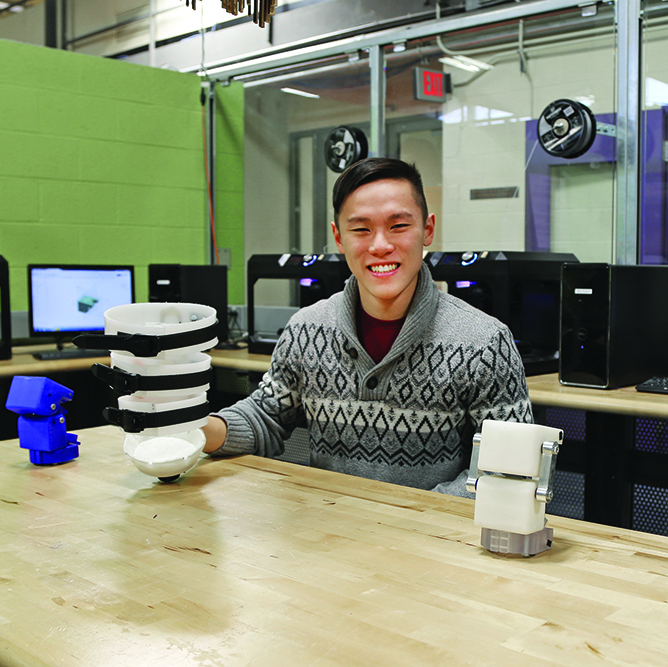Enabling the disabled with affordable prosthetics
With help from the Doris M. and Norman T. Halpin Senior Capstone Prize and fellow Brown students, Matthew Lo ’18 is designing an affordable prosthetic leg that could change the lives of amputees in developing countries.
 Making a difference through human-centered design has been a guiding interest of Matthew Lo ’18 since his arrival at Brown. The biomedical engineering concentrator from Westwood, Mass. wants to increase prosthetic availability, especially in countries where accessibility to such devices is severely limited.
Making a difference through human-centered design has been a guiding interest of Matthew Lo ’18 since his arrival at Brown. The biomedical engineering concentrator from Westwood, Mass. wants to increase prosthetic availability, especially in countries where accessibility to such devices is severely limited.
According to the World Health Organization, only five percent of the 40 million amputees in developing countries have access to prosthetics because of high costs and a lack of adequate health care. In Vietnam alone, more than four million people have disabilities due to traffic accidents and the legacies of war.
Last spring, Matt’s twin brother, Alexander Lo ’18, also a biomedical engineering concentrator, attended the Brown/RISD STEAM (Science, Technology, Engineering, Art and Math) Assistive Tech Makeathon, a two-day session in the Brown Design Workshop (BDW). There Alex met the founders of Penta, a Brown/ Yale collaborative startup founded in 2015 to bring high quality, low-cost prosthetics to Vietnam by repurposing used equipment from the United States.
The Los had already been thinking about prosthetic ideas, based on a mutual interest in biomechanics and the BrownConnect Linking Internships and Knowledge awards that allowed them to intern at Mass General’s Sports Orthopedic Lab. Penta was immediately interested, and asked the duo to bring together a team. This past summer, a small group traveled to Vietnam to observe the user environment and talk to local prosthetic specialists and amputees.
“Thanks to Penta we were able to go to Vietnam, and begin to realize the full potential for change that an affordable prosthetic could have,” Matt said. It was here the Koi team was born, developing a preliminary prototype of an active knee. “Koi fish are a symbol for overcoming adversity, and it was a recurring symbol we came across in Southeast Asia. It also represents our origin: Wherever our company ends up, we started in Vietnam with the prevailing mission to help people overcome adversities.”
“We all thought this project was a great way to apply our interests,” said Koi team member Luke Morales ’18, a biomedical engineering concentrator. “Helping people is definitely a unifying point for us.”
Upon their return, the group approached Engineering Professor Anubhav Tripathi with their first iteration. “He liked the idea,” Matt recalls. “He knew there was a need for it, and wanted us to expand to other prosthetic devices.
“We want to help people, and with Brown’s resources, we think this is possible. The funds will help establish our company and also allow us to keep testing.”
The senior team members enrolled in the Biomedical Engineering Capstone course, where they could be advised by clinicians and healthcare professionals to address design challenges. Matt and Alex joined up with mechanical engineering’s Franklin Tarte ’18 to fabricate a universal socket for a residual limb, while team members Morales, Claire Sise ’18 and Justin Lee ’18 designed an adjustable pylon (shin) for pediatric patients.
We couldn’t do any of this without the Halpin prize money. We want to help people, and with Brown’s resources, we think this is possible. The funds helped establish our company and also allow us to keep testing.
This semester, the group focused on formulating their business model, and gauging the interest of investors. “We couldn’t do any of this without the Halpin prize money,” Matt said. “We want to help people, and with Brown’s resources, we think this is possible. The funds helped establish our company and also allow us to keep testing.”
Koi’s current knee design utilizes a four-bar linkage system to mimic natural gait and incorporates a spring system to eliminate strain on muscles. The plan is to use a self-lubricating, high-grade polymer with customizable parts, making the cost to amputees less than $20. The team presented its design at the 2017 New York Maker Faire last September.
Moving forward, Koi will test new materials and use the BDW—where Matt, Alex, and Matthew Borges ’19 are monitors—as a homebase for rapid prototyping. Several members of the team have decided to stay at Brown to earn their fifth year master’s degree.
“Our future efforts,” Matt said, “will be to build on the strong foundation we already have and to create a business model that will make product distribution easier.”